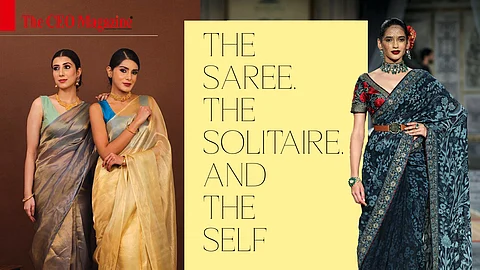
- News
- Women
- Magazine
- IndustryIndustry
- InsightsInsights
- Success Stories
- PublishPublish
- ContactContact
- Media KitMedia Kit

The Saree, The Solitaire, and The Self
Power dressing in India doesn’t always stride in with a sharp blazer. Sometimes, it arrives in a handwoven saree, a bold bindi, or a single diamond solitaire worn with quiet pride. Indian women leaders today aren’t borrowing from global norms of authority; they’re rewriting the code entirely, using style as a form of self-expression and self-respect.
This shift is not loud or reactionary. It’s thoughtful, personal, and rooted in choice. These are women who no longer feel the need to “blend in” to be taken seriously. Their authority is non-negotiable. What they wear is simply a reflection of how they carry it.
The saree’s return to boardrooms, parliaments, courtrooms, and stages is not about tradition for tradition’s sake. It’s about control. When a leader picks a crisp cotton or a rich silk over Western formals, she’s not trying to make a cultural statement; she’s owning her space in a way that feels natural to her.
You’ll see younger professionals pairing handlooms with sneakers or belting a saree over a blouse with structured shoulders. You’ll see seasoned women executives show up in starched whites or jewel-toned weaves, commanding rooms without raising their voices. It’s not about nostalgia. It’s about knowing exactly who they are.
Gone are the days when jewellery was reserved for weddings or temple visits. Today, a single unmissable solitaire or a stack of delicate gold bangles can do the talking in a meeting just as well as any title.
Modern Indian women leaders are choosing pieces that carry memory, meaning, or both. A grandmother’s ring worn during a crucial pitch. Temple jewellery styled with a monochrome dress. A mangalsutra reimagined as a pendant worn daily. These aren’t accessories; they’re part of a personal narrative.
Jewellery, for them, is not about excess. It’s about essence. A symbol of financial freedom. A nod to heritage. A reminder of where they come from, even when they’re forging entirely new paths.
Today’s power dressing is anything but static. Sarees are being draped to allow movement. Jewellery is being worn for impact, not weight. Fabrics are chosen for both beauty and breathability. Comfort isn’t sacrificed for formality anymore.
This new aesthetic is responsive. It adapts to the roles women play, the rooms they enter, and the work they do. A woman might wear a handwoven linen saree with silver hoops to a strategy meeting, then switch to a raw silk with a bold necklace for a keynote address. What remains constant is intention.
There’s a quiet strength in the way Indian women now use clothing and jewellery to shape how they are seen and how they see themselves. Style becomes a form of communication. It signals clarity. Confidence. Command.
This isn’t about rejecting Western power dressing. It’s about expanding the definition. Including more stories. Allowing more textures, voices, and histories to enter the room. For Indian women leaders, the saree and the solitaire don’t dilute professionalism; they deepen it.
Perhaps the most striking part of this evolution is how naturally it’s unfolding. There is no single rulebook anymore. One woman might wear a sari every day. Another may reserve it for moments that matter. One may choose heirloom jewellery as armour. Another may leave her ears bare but wear a ring that’s been with her since her first job. Each version is valid. Each voice is powerful.
In the end, power dressing for Indian women is no longer about fitting into a box. It’s about honouring the self. The saree, the solitaire, the subtle choices – they’re all part of a much larger story. One that doesn’t need translation.
Follow us on Google News
